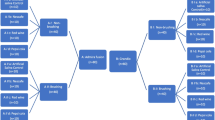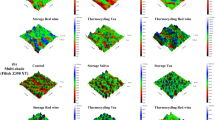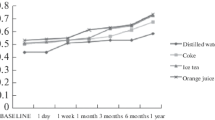The purpose of this study is to evaluate the effects of different acidic beverages on the surface roughness, microhardness, flexural strength, and elastic modulus of microhybrid, bulk-fill, and injectable composites and the correlations between them. Microhybrid, bulk-fill, and injectable composites were used in this study. One hundred and thirty-five disk-shaped samples were prepared for the microhardness test and the surface roughness measurements, and 675 rectangular prism-shaped samples were prepared for elastic modulus and flexural strength measurements. In each sample, the initial surface roughness, microhardness, flexural strength, and elastic modulus were measured and then randomly divided into three groups (n = 15) in preparation for the immersion procedure in coke, orange juice, and artificial saliva. Relevant measurements were repeated on the first day, first week, first month, and first year after the immersion procedure was performed with each beverage. Moreover, the effects of the beverage on surface morphology were evaluated by scanning electron microscopy at the relevant control times. A three-way analysis of variance was used to compare microhardness, surface roughness, flexural strength, and elastic modulus measurement values according to the material, beverage, and immersion cycle, and Tukey’s test was used for multiple comparisons. Spearman’s rho correlation coefficient was used to examine relationships between parameters. The significance level was p< 0.05. Statistically significant effects were found on the surface roughness values of the materials, beverages, immersion cycle times, as well as the interactions among these parameters (p< 0.001). The highest surface roughness value of 5.28 was obtained in the injectable composite group, which was exposed to a one-year coke immersion cycle. After the immersion cycle, a significant decreasing trend in the microhardness value was detected in all materials (p< 0.001). It was determined that the injectable composite had the highest flexural strength value (173.6 MPa). The lowest flexural strength value was determined to be in the microhybrid composite group (92.9 MPa) before the immersion procedure. Moreover, a significant decrease was observed in the flexural strength and elastic modulus values of all composite groups that were subjected to the immersion cycle with coke, while this change was minimal in artificial saliva. The injectable composite exposed to short- and long-term immersion cycles exhibited a flexural strength value above ISO 4049/2019 standards, which is promising for clinical use.







Similar content being viewed by others
References
M. A. Buzalaf, A. R. Hannas, and M. T. Kato, “Saliva and dental erosion,” J. Appl. Oral Sci., 20, 493–502 (2012).
A. C. Mafla, X. A. Ceron-Bastidas, M. E. Munoz-Ceballos, et al., “Prevalence and extrinsic risk factors for dental erosion in adolescents,” J. Clin. Pediatr. Dent., 41, 102–111 (2017).
A. S. Qutieshat, A. G. Mason, and R. G. Chadwick, “In vitro simulation of erosive challenges to human enamel using a novel artificial mouth,” Clin. Exp. Dent. Res., 4, 105–112 (2018).
Y. Li, F. Yu, L. Niu, et al., “Associations among bruxism, gastroesophageal reflux disease, and tooth wear,” J. Clin. Med., 7, 417 (2018).
D. Bartlett and S. O’Toole, “Tooth wear and aging,” Aust. Dent. J., 64, Suppl. 1, s59–s62 (2019).
T. K. Tedesco, A. F. B. Calvo, L. Yoshioka, et al., “Does acid challenge affect the properties and bond stability of restorative materials on primary teeth?,” J. Adhes. Dent., 20, 223–231 (2018).
M. G. Borges, C. J. Soares, T. S. Maia, et al., “Effect of acidic drinks on shade matching, surface topography, and mechanical properties of conventional and bulk-fill composite resins,” J. Prosthet. Dent., 121, 868.e–868.e8 (2019).
J. Chesterman, A. Jowett, A. Gallacher, et al., “Bulk-fill resin-based composite restorative materials: a review,” Br. Dent. J., 222, 337–344 (2017).
L. Rosa de Lacerda, M. Bossardi, W. J. Silveira Mitterhofer, et al., “New generation bulk-fill resin composites: Effects on mechanical strength and fracture reliability,” J. Mech. Behav. Biomed. Mater., 96, 214–218 (2019).
A. Imai, T. Takamizawa, R. Sugimura, et al., “Interrelation among the handling, mechanical, and wear properties of the newly developed flowable resin composites,” J. Mech. Behav. Biomed. Mater., 89, 72–80 (2019).
J. Lin, M. Sun, Z. Zheng, et al., “Effects of rotating fatigue on the mechanical properties of microhybrid and nanofiller-containing composites,” Dent. Mater. J., 32, 476–483 (2013).
S.-Y. Seon, I.-G. Yun, J.-E. Kim, et al., “Dental erosive effects of fluoride-containing tea beverages with low pH,” J. Korean. Acad. Oral Health, 42, 118–123 (2018).
A. U. Yap, S. H. Tan, S. S. Wee, et al., “Chemical degradation of composite restoratives,” J. Oral Rehabil., 28, 1015–1021 (2001).
C. Poggio, M. Viola, M. Mirando, et al., “Microhardness of different esthetic restorative materials: Evaluation and comparison after exposure to acidic drink,” Dent. Res. J. (Isfahan), 15, 166–172 (2018).
A. Scribante, S. Gallo, S. Scarantino, et al., “Exposure of biomimetic composite materials to acidic challenges: Influence on flexural resistance and elastic modulus,” Biomimetics (Basel), 5, 56 (2020).
M. R. Ayatollahi, M. Y. Yahya, A. Karimzadeh, et al., “Effects of temperature change and beverage on mechanical and tribological properties of dental restorative composites,” Mater. Sci. Eng. C, 54, 69–75 (2015).
A. Scribante, M. Bollardi, M. Chiesa, et al., “Flexural properties and elastic modulus of different esthetic restorative materials: Evaluation after exposure to acidic drink,” Biomed. Res. Int., 2019, 5109481 (2019).
S. Tanthanuch, B. Kukiattrakoon, O. P. K. Eiam, et al., “Surface changes of various bulk-fill resin-based composites after exposure to different food-simulating liquid and beverages,” J. Esthet. Dent., 30, 126–135 (2018).
I. M. Hamouda, “Effects of various beverages on hardness, roughness, and solubility of esthetic restorative materials,” J. Esthet. Dent., 23, 315–322 (2011).
P. S. Reddy, K. L. Tejaswi, S. Shetty, et al., “Effects of commonly consumed beverages on surface roughness and color stability of the nano, microhybrid and hybrid composite resins: an in vitro study,” J. Contemp. Dent., 14, 718–723 (2013).
L. Shalan, “Effect of acidic and energy drinks on surface roughness of three types of bulk fill composite materials,” J. Baghdad Coll. Dent., 28, 8–14 (2016).
G. Elwardani, A. A. Sharaf, and A. Mahmoud, “Evaluation of colour change and surface roughness of two resin-based composites when exposed to beverages commonly used by children: an in-vitro study,” Eur. Arch. Paediatr. Dent., 20, 267–276 (2019).
C. M. Meenakshi and K. Sirisha, “Surface quality and color stability of posterior composites in acidic beverages,” J. Conserv. Dent., 23, 57–61 (2020).
E. A. Munchow, M. B. Correa, F. A. Ogliari, et al., “Correlation between surface roughness and microhardness of experimental composites with varying filler concentration,” J. Contemp. Dent., 13, 299–304 (2012).
M. El Gezawi, D. Kaisarly, H. Al-Saleh, et al., “Degradation potential of bulk versus incrementally applied and indirect composites: Color, microhardness, and surface deterioration,” Oper. Dent., 41, e195–e208 (2016).
M. A. B. Da Silva, R. P. Vitti, M. A. C. Sinhoreti, et al., “Effect of alcoholic beverages on surface roughness and microhardness of dental composites,” Dent. Mater. J., 35, 621–626 (2016).
D. Tantbirojn, C. S. Pfeifer, R. R. Braga, et al., “Do low-shrink composites reduce polymerization shrinkage effects?,” J. Dent. Res., 90, 596–601 (2011).
A. Nemati Giv, S. Rastegar, and M. Ozcan, “Influence of nanoclays on water uptake and flexural strength of glass-polyester composites,” J. Appl. Biomater. Funct., 18, 2280800020930180 (2020).
E. Mohammadi, L. Pishevar, and P. Mirzakouchaki Boroujeni, “Effect of food simulating liquids on the flexural strength of a methacrylate and silorane-based composite,” PLoS One, 12, e0188829 (2017).
ISO 4049:2019. Dentistry – Polymer-Based Restorative Materials.
Author information
Authors and Affiliations
Corresponding author
Additional information
Translated from Problemy Mitsnosti, No. 2, p. 109, March – April, 2022.
Rights and permissions
About this article
Cite this article
Degirmenci, A., Degirmenci, B.U. & Salameh, M. Long-Term Effect of Acidic Beverages on Dental Injectable Composite Resin: Microhardness, Surface Roughness, Elastic Modulus, and Flexural Strength Patterns. Strength Mater 54, 331–343 (2022). https://doi.org/10.1007/s11223-022-00409-z
Received:
Published:
Issue Date:
DOI: https://doi.org/10.1007/s11223-022-00409-z




